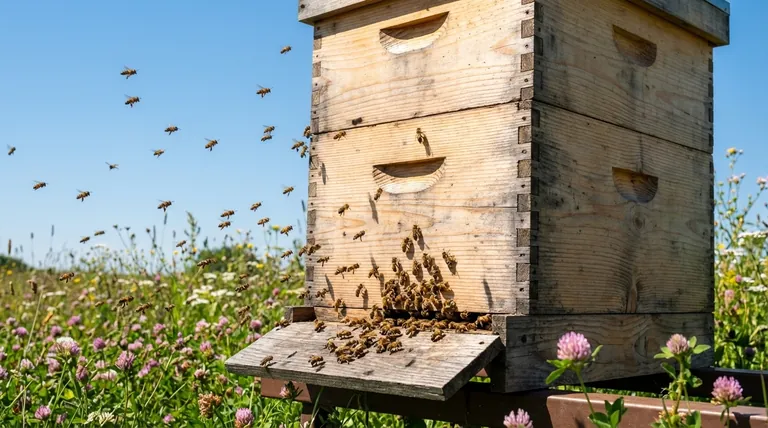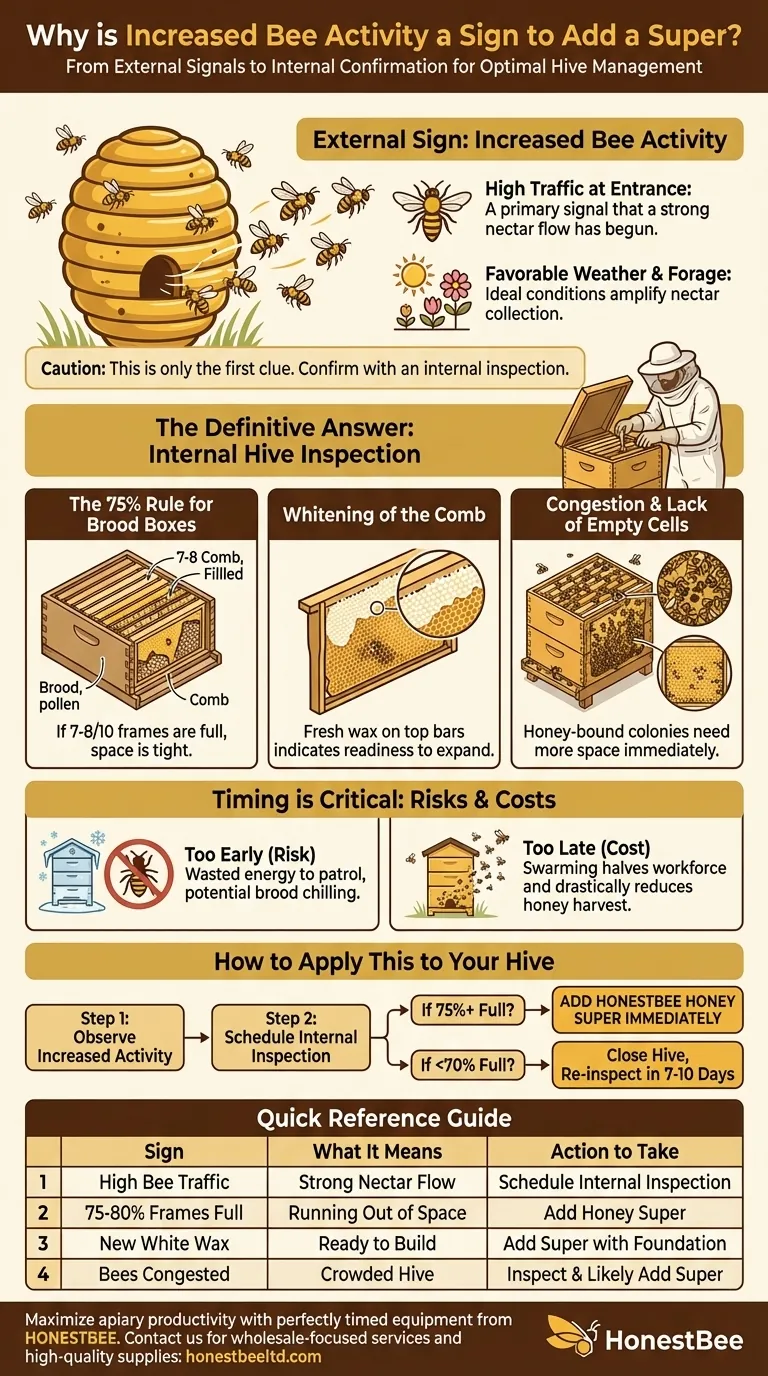Increased bee activity is a primary external signal that a strong nectar flow has begun, meaning the colony is bringing in resources faster than they can store them. This high traffic at the entrance is your cue to look inside the hive for more definitive signs that they need a honey super for additional storage.
The core challenge for any beekeeper is adding space at precisely the right time. Increased bee activity is a strong clue, but it must be confirmed by an internal hive inspection to ensure you are meeting the colony's needs without giving them too much space to manage.

Why External Activity is Only the First Clue
A busy hive entrance is an exciting sight. It signals that foraging conditions are ideal and the colony's workforce is operating at peak efficiency. However, this external sign must be put into context.
High Traffic at the Entrance
A noticeable increase in bees coming and going is the most obvious sign that a major nectar flow is underway. Foragers are working hard, and the sheer volume of incoming nectar will quickly fill any available space within the brood boxes.
Favorable Weather and Forage
This increased activity is directly tied to environmental conditions. Sunny, warm days combined with blooming floral sources (like clover, basswood, or local wildflowers) create the perfect storm for nectar collection. This predictable pattern helps you anticipate when to be ready.
The Definitive Answer: Inspecting Inside the Hive
While external activity tells you a nectar flow is on, an internal inspection tells you if the bees have run out of room. The decision to add a super should only be made after confirming the conditions inside the hive.
The 75% Rule for Brood Boxes
This is the most reliable metric. Open your top brood box and see how many frames the bees are actively using. If 7 to 8 of the 10 frames (or 6 to 7 of 8 frames) are drawn out with comb and contain brood, pollen, or honey, the box is considered full. This is the clearest sign they need more space.
"Whitening" of the Comb
When bees are ready to expand, they begin producing fresh beeswax. Look for new, white wax being built up along the top bars of the frames in the uppermost box. This is a clear indicator that the bees are in "construction mode" and are looking for new space to build.
Congestion and A Lack of Empty Cells
A generally congested hive, with bees covering the tops of the frames when you first open the lid, shows that space is tight. If you pull a frame and see that nearly every cell is filled with brood, pollen, or nectar—with no empty cells for the queen to lay in—the colony is becoming "honey-bound."
Understanding the Trade-offs: Timing is Critical
Adding a super isn't just about giving bees more room; it's about timing it correctly to support the colony's health and productivity.
The Risk of Adding a Super Too Early
If you add a super before the brood box is sufficiently full, you create a large cavity of empty space. The colony must expend extra energy to patrol this space against pests like wax moths and to regulate its temperature, potentially chilling the brood on cold nights.
The Cost of Adding a Super Too Late
Waiting too long is far more detrimental. With no space to store incoming nectar or for the queen to lay eggs, the colony will feel crowded. This triggers their natural reproductive instinct: swarming. They will create queen cells, and half your workforce will leave with the old queen, drastically reducing your potential honey harvest.
How to Apply This to Your Hive
Use a simple, two-step process to make your decision with confidence.
- If you see a significant increase in bee activity: This is your trigger to schedule an internal hive inspection within the next few days.
- If your top brood box is 75-80% full during inspection: Add the honey super immediately to capture the nectar flow and prevent the hive from preparing to swarm.
- If your brood box is less than 70% full: The bees still have adequate space. Close up the hive and plan to re-inspect in another 7-10 days.
By combining external observation with a clear internal benchmark, you can manage your hives proactively and ensure a healthy colony and a successful honey harvest.
Summary Table:
| Sign | What It Means | Action to Take |
|---|---|---|
| High Bee Traffic at Entrance | Strong nectar flow is likely underway. | Schedule an internal hive inspection. |
| 75-80% of Top Brood Box Frames Full | Bees are running out of storage and brood space. | Add a honey super immediately. |
| New White Wax on Top Bars | Bees are ready to build and expand. | Add a super with foundation/frames. |
| Bees Congested on Top of Frames | The hive is crowded and space is limited. | Inspect frames; likely time to add a super. |
Maximize your apiary's productivity with perfectly timed equipment from HONESTBEE.
For commercial apiaries and beekeeping equipment distributors, managing hive space efficiently is critical for colony health and honey yield. HONESTBEE supplies the durable, high-quality honey supers and beekeeping equipment you need to scale your operations with confidence through our wholesale-focused services.
Contact our expert team today to discuss your equipment needs and secure reliable supplies for the season!
Visual Guide

Related Products
- Langstroth Honey Bee Box Hive Boxes for Different Depths
- Professional 500g Sectional Comb Honey Frame System for Beekeeping
- Australian Langstroth Beehive Boxes for Beekeeping Wholesales
- Portable Bee Mating Hive Boxes Mini Mating Nucs 8 Frames for Queen Rearing
- Twin Queen Styrofoam Honey Bee Nucs Mating and Breeding Box
People Also Ask
- What is the purpose of the boxes in a Langstroth hive? A Guide to Modular Beekeeping Success
- How is checking honey supers in a Langstroth hive different from inspecting Honey Flow supers? A Guide to Disruptive vs. Non-Invasive Methods
- How deep is a medium bee box? Unlock the Key to a Versatile and Manageable Hive
- How does a hive box work? A Guide to the Langstroth Hive System for Beekeepers
- What are the sizes of supers available in a standard hive? A Guide to Deep, Medium, and Shallow Boxes



















